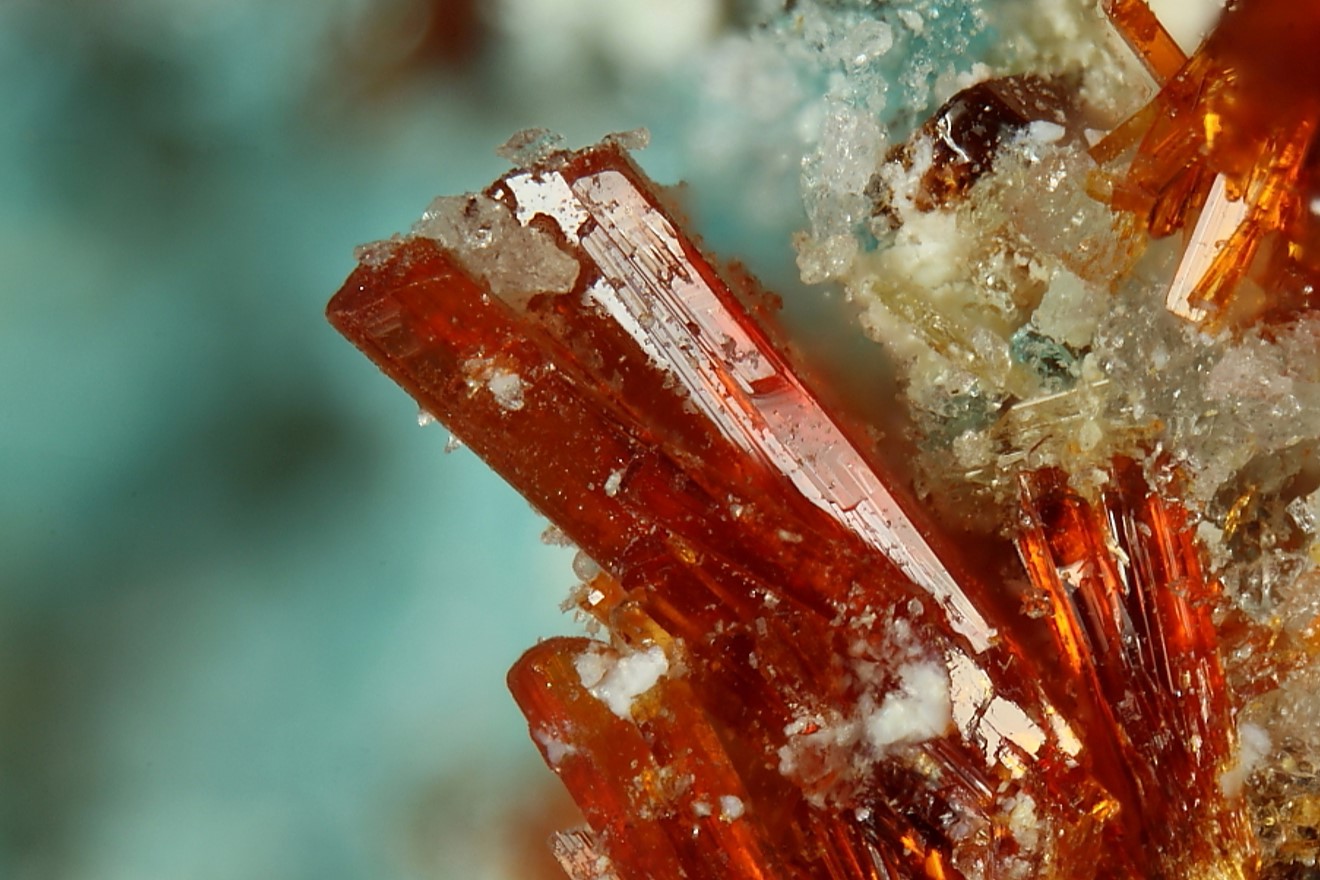
Amarantite is a rare and captivating mineral that stands out due to its vibrant red to brownish hues and unique triclinic crystal structure. This sulfate mineral, with the chemical formula Fe3+2O(SO4)2·7H2O, is not just a visual marvel but also a subject of scientific intrigue. Found primarily in Carocoles, Chile, amarantite's rarity makes it a prized specimen for collectors and researchers alike. Its name, derived from the Greek word for the undying amaranth flower, hints at its enduring beauty. What makes amarantite so special? Let's explore 25 fascinating facts about this extraordinary mineral.
What is Amarantite?
Amarantite is a rare and captivating mineral that has intrigued scientists and collectors alike. Its unique properties and vibrant color make it a standout in the world of minerals. Let's dive into some fascinating facts about this extraordinary mineral.
-
Definition and Classification
Amarantite is a sulfate mineral with the chemical formula Fe3+2O(SO4)2·7H2O or Fe3+SO4(OH)·3H2O. It belongs to the sulfate class of minerals and is categorized under the Strunz classification as 7.DB.30. -
Crystal System and Structure
Amarantite is triclinic, meaning it has only one symmetry fold. This unique crystal structure requires a 360-degree rotation to be exactly the same, making it anisotropic. The crystal system of amarantite is characterized by different lengths for the sides of each axis, and the angles between these axes do not equal 90 degrees.
Optical and Physical Properties
Understanding the optical and physical properties of amarantite helps in identifying and appreciating this mineral's unique characteristics.
-
Optical Properties
Amarantite exhibits biaxial optical properties, which means that the velocity of light varies with crystallographic direction. It has three different refractive indices: nα = 1.516, nβ = 1.598, and nγ = 1.621. The birefringence of amarantite is δ = 0.105, and it shows pleochroism with colors ranging from colorless to pale yellow to reddish brown. -
Color and Appearance
Amarantite is known for its vibrant red to brownish color, which is reminiscent of the amaranth flower. The name "amarantite" comes from the Greek word αμάραντος, meaning "amaranth," an imaginary undying red flower. -
Hardness and Tenacity
Amarantite has a Mohs hardness of 2.5 and is brittle in nature. Its tenacity is brittle, indicating that it can break easily without deforming. -
Cleavage and Crystal Habit
Amarantite exhibits perfect cleavage on the {010} and {100} planes. It often forms radiating or matted aggregates of needles and may appear columnar or bladed in crystal habit. -
Specific Gravity and Diaphaneity
The specific gravity of amarantite ranges from 2.189 to 2.286, indicating its relatively dense nature. It is transparent in diaphaneity, allowing light to pass through it.
Geological and Historical Significance
Amarantite's rarity and formation processes add to its intrigue and value among collectors and scientists.
-
Geological Occurrence
Amarantite is a very rare mineral and can only be found in a few locations around the world. One of the primary places where it is discovered is Carocoles, Chile. Its rarity makes it highly sought after by mineral collectors. -
Iron Content
Despite its rarity, amarantite is a source of iron. However, due to its limited availability, it is not mined for iron. Instead, it is valued for its unique crystal form and vibrant color. -
Historical Significance
Amarantite has been of interest to mineral collectors and scientists for centuries. Its unique properties and rarity have contributed to its historical significance in the field of mineralogy. -
Cultural Significance
The name "amarantite" is derived from the Greek word for amaranth, an imaginary flower known for its enduring beauty. This cultural reference highlights the mineral's aesthetic appeal and its place in the broader cultural context of beauty and rarity.
Mineralogical and Structural Complexity
The mineralogical classification and structural complexity of amarantite make it a subject of study and admiration.
-
Mineralogical Classification
In mineralogical classification, amarantite is part of the sulfate group. This classification is based on its chemical composition and crystal structure, which are characteristic of sulfate minerals. -
Structural Complexity
Amarantite's triclinic structure makes it one of the more complex minerals in terms of crystallography. Its anisotropic nature and multiple refractive indices contribute to its structural complexity.
Formation and Stability
The formation processes and stability of amarantite are fascinating aspects that reveal much about its nature.
-
Formation Processes
The formation of amarantite involves complex geological processes. It is believed to form through the oxidation of iron-rich minerals in specific environments, such as those found in oxidation zones and mine wastes. -
Metastable Mineral Formation
Amarantite can be considered a metastable mineral, meaning it exists in a state that is not thermodynamically stable. However, it persists in its metastable form due to kinetic factors, such as its slow conversion to more stable phases. -
Ostwald's Step Rule
The formation of amarantite follows Ostwald's step rule, which states that initial precipitation occurs in structurally simple phases that may transform to more complex phases over time. This rule explains the formation of metastable minerals like amarantite.
Environmental and Field Observations
Field observations and environmental factors play a crucial role in the formation and persistence of amarantite.
-
Geological Environments
Amarantite is typically found in near-surface environments, such as oxidation zones and mine wastes. These areas are characterized by metal-rich, near-surface conditions that facilitate the formation of metastable minerals. -
Surface Energy and Stability
The stability of amarantite is influenced by its surface energy. In near-surface environments, minerals like amarantite can be stabilized by their high specific surface areas, which affect their crystallization and persistence. -
Field Observations
Field studies have shown that amarantite forms through the precipitation of metastable phases from aqueous solutions. These phases can transform into more stable forms over time, but amarantite's unique properties allow it to persist in its metastable state.
Crystallographic and Optical Analysis
Detailed analysis of amarantite's crystallographic and optical properties provides deeper insights into its nature.
-
Crystallographic Analysis
The crystallographic analysis of amarantite reveals its triclinic structure, which is characterized by different lengths for the sides of each axis and non-90-degree angles between these axes. This unique structure contributes to its anisotropic optical properties. -
Refractive Indices and Birefringence
Amarantite's refractive indices (nα = 1.516, nβ = 1.598, nγ = 1.621) and birefringence (δ = 0.105) are significant in its optical properties. These values indicate the mineral's ability to refract light differently in various directions. -
Pleochroism and Color Variations
Amarantite exhibits pleochroism, showing different colors when viewed from different directions. The colors range from colorless to pale yellow to reddish brown, adding to its aesthetic appeal and scientific interest.
Cleavage, Hardness, and Tenacity
The physical properties of amarantite, such as cleavage, hardness, and tenacity, are essential for understanding its behavior and handling.
-
Cleavage and Crystal Habit
The perfect cleavage on the {010} and {100} planes of amarantite makes it prone to breaking along these planes. Its crystal habit can appear as radiating or matted aggregates of needles, which are characteristic of its formation processes. -
Hardness and Tenacity
Amarantite's hardness of 2.5 and brittle tenacity indicate that it is relatively soft and can break easily without deforming. This property makes it more susceptible to damage during handling or exposure to environmental factors.
Cultural and Scientific Significance
Amarantite's unique properties and rarity make it highly valued by both scientists and collectors. Its cultural significance extends beyond its scientific importance, as it serves as a symbol of beauty and rarity in the mineral kingdom.
- Cultural and Scientific Significance
Amarantite's unique properties and rarity make it highly valued by both scientists and collectors. Its cultural significance extends beyond its scientific importance, as it serves as a symbol of beauty and rarity in the mineral kingdom.
The Fascinating World of Amarantite
Amarantite stands out with its vibrant red to brownish color and unique triclinic crystal structure. This rare sulfate mineral, found mainly in Carocoles, Chile, captivates both scientists and collectors. Its complex formation process, involving the oxidation of iron-rich minerals, adds to its intrigue. Despite its brittle nature and Mohs hardness of 2.5, amarantite's perfect cleavage and radiating needle-like aggregates make it visually striking.
Its optical properties, including pleochroism and multiple refractive indices, further enhance its appeal. Though not mined for iron, its iron content and rarity contribute to its value. The name "amarantite," derived from the Greek word for the undying amaranth flower, underscores its enduring beauty. This mineral's cultural and scientific significance, combined with its unique properties, solidifies its place as a gem in the mineral kingdom.
Was this page helpful?
Our commitment to delivering trustworthy and engaging content is at the heart of what we do. Each fact on our site is contributed by real users like you, bringing a wealth of diverse insights and information. To ensure the highest standards of accuracy and reliability, our dedicated editors meticulously review each submission. This process guarantees that the facts we share are not only fascinating but also credible. Trust in our commitment to quality and authenticity as you explore and learn with us.


